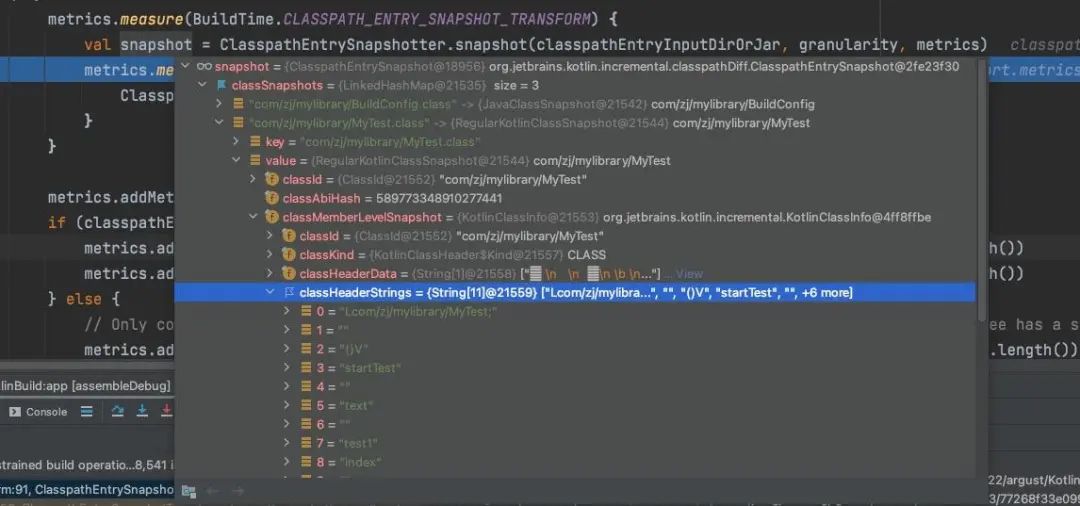
本文原作者: 程序员江同学,原文发布于: 程序员江同学
编译运行是一个 Android 开发者每天都要做的工作,增量编译对于开发者也极其重要,高命中率的增量编译可以极大的提高开发者的开发效率与体验。我们今天一起来看下 Kotlin 增量编译的源码,看看 Kotlin 增量编译到底是怎么实现的。

增量编译流程
第一步: 编译入口
如果我们要在项目中使用 Kotlin,都必须要添加 org.jetbrains.kotlin.android 插件,这个插件是我们编译 Kotlin 的入口,它的代码在 kotlin-gradle-plugin 插件中。
这个插件的实现类就是 KotlinAndroidPluginWrapper,可以看出 KotlinAndroidPluginWrapper 就是个包装,里面主要就是创建并配置 KotlinAndroidPlugin。
第二步: 配置 KotlinAndroidPlugin
KotlinAndroidPlugin 是插件真正的入口,在这里完成 compileKotlin Task 相关的配置工作。
internal open class KotlinAndroidPlugin(
private val registry: ToolingModelBuilderRegistry
) : Plugin<Project> {
override fun apply(project: Project) {
checkGradleCompatibility()
project.dynamicallyApplyWhenAndroidPluginIsApplied()
}
private fun preprocessVariant(
variantData: BaseVariant,
compilation: KotlinJvmAndroidCompilation,
project: Project,
rootKotlinOptions: KotlinJvmOptionsImpl,
tasksProvider: KotlinTasksProvider
) {
val configAction = KotlinCompileConfig(compilation)
configAction.configureTask { task ->
task.useModuleDetection.value(true).disallowChanges()
// 将kotlin 编译结果存储在tmp/kotlin-classes/$variantDataName目录下,会作为java compiler的class-path输入
task.destinationDirectory.set(project.layout.buildDirectory.dir("tmp/kotlin-classes/$variantDataName"))
}
tasksProvider.registerKotlinJVMTask(project, compilation.compileKotlinTaskName, compilation.kotlinOptions, configAction)
}
}省略了一些代码,主要做了几件事:
检查 KGP 与 Gradle 的版本兼容,如果不兼容则抛出异常,中止构建;
如果在 project 中已经添加了 Android 插件,则开始配置 kotlin-android 插件;
通过 KotlinCompileConfig 来配置 KotlinCompile Task,设置 destinationDirectory 作为 Kotlin 编译结果存储目录,后续会作为 java compiler 的 classpath 输入。
第三步: 配置 KotlinCompile 的输入输出
要实现增量编译,最重要的一点就是配置输入输出,当输入输出没有发生变化时,Task 就可以被跳过,而 KotlinCompile 输入输出的配置,主要是在 KotlinCompileConfig 中完成的。
configureTaskProvider { taskProvider ->
// 是否开启classpathSnapthot
val useClasspathSnapshot = propertiesProvider.useClasspathSnapshot
val classpathConfiguration = if (useClasspathSnapshot) {
// 注册 Transform
registerTransformsOnce(project)
project.configurations.detachedConfiguration(
project.dependencies.create(objectFactory.fileCollection().from(project.provider { taskProvider.get().libraries }))
)
} else null
taskProvider.configure { task ->
// 配置输入属性
task.classpathSnapshotProperties.useClasspathSnapshot.value(useClasspathSnapshot).disallowChanges()
if (useClasspathSnapshot) {
// 通过TransformAction读取输入
val classpathEntrySnapshotFiles = classpathConfiguration!!.incoming.artifactView {
it.attributes.attribute(ARTIFACT_TYPE_ATTRIBUTE, CLASSPATH_ENTRY_SNAPSHOT_ARTIFACT_TYPE)
}.files
task.classpathSnapshotProperties.classpathSnapshot.from(classpathEntrySnapshotFiles).disallowChanges()
task.classpathSnapshotProperties.classpathSnapshotDir.value(getClasspathSnapshotDir(task)).disallowChanges()
} else {
task.classpathSnapshotProperties.classpath.from(task.project.provider { task.libraries }).disallowChanges()
}
}
}可以看出,主要做了这么几件事:
判断是否开启了 classpathSnapthot,这也是支持跨模块增量编译的开关,如果开启了就注册 Transform;
通过 TransformAction 获取输入,并配置给 Task 相应的属性。
下面我们着重来看下 TransformAction 在这里做了什么工作?
第四步: 跨模块增量编译支持
private fun registerTransformsOnce(project: Project) {
val buildMetricsReporterService = BuildMetricsReporterService.registerIfAbsent(project)
project.dependencies.registerTransform(ClasspathEntrySnapshotTransform::class.java) {
it.from.attribute(ARTIFACT_TYPE_ATTRIBUTE, JAR_ARTIFACT_TYPE)
it.to.attribute(ARTIFACT_TYPE_ATTRIBUTE, CLASSPATH_ENTRY_SNAPSHOT_ARTIFACT_TYPE)
}
project.dependencies.registerTransform(ClasspathEntrySnapshotTransform::class.java) {
it.from.attribute(ARTIFACT_TYPE_ATTRIBUTE, DIRECTORY_ARTIFACT_TYPE)
it.to.attribute(ARTIFACT_TYPE_ATTRIBUTE, CLASSPATH_ENTRY_SNAPSHOT_ARTIFACT_TYPE)
}
}了解了前置知识中的 TransformAction,可以看出这就是注册了只变换 ArtifactType 的变换,主要涉及 JAR_ARTIFACT_TYPE 和 DIRECTORY_ARTIFACT_TYPE 转换为 CLASSPATH_ENTRY_SNAPSHOT_ARTIFACT_TYPE。
也就是说依赖的 jar 和类目录都会转换为 CLASSPATH_ENTRY_SNAPSHOT_ARTIFACT_TYPE 类型,也就可以获取我们依赖的所有 classpath 的 abi 了。
接下来我们看下 ClasspathEntrySnapshotTransform 的实现。
abstract class ClasspathEntrySnapshotTransform : TransformAction<ClasspathEntrySnapshotTransform.Parameters> {
@get:Classpath
@get:InputArtifact
abstract val inputArtifact: Provider<FileSystemLocation>
override fun transform(outputs: TransformOutputs) {
val classpathEntryInputDirOrJar = inputArtifact.get().asFile
val snapshotOutputFile = outputs.file(classpathEntryInputDirOrJar.name.replace('.', '_') + "-snapshot.bin")
val granularity = getClassSnapshotGranularity(classpathEntryInputDirOrJar, parameters.gradleUserHomeDir.get().asFile)
val snapshot = ClasspathEntrySnapshotter.snapshot(classpathEntryInputDirOrJar, granularity, metrics)
ClasspathEntrySnapshotExternalizer.saveToFile(snapshotOutputFile, snapshot)
}
/**
* 如果是anroid.jar或者aar依赖,粒度为class, 否则为class_member_level
/
private fun getClassSnapshotGranularity(classpathEntryDirOrJar: File, gradleUserHomeDir: File): ClassSnapshotGranularity {
return if (
classpathEntryDirOrJar.startsWith(gradleUserHomeDir) ||
classpathEntryDirOrJar.name == "android.jar"
) CLASS_LEVEL
else CLASS_MEMBER_LEVEL
}
}△ ClasspathEntrySnapshotTransform 实现
关于自定义 TransformAction,其实跟 Task 一样,也主要看 3 个部分,输入,输出,执行方法体:
ClasspathEntrySnapshotTransform 的输入就是模块依赖的 jar 或者文件目录;
输出则是以 -snapshot.bin 结尾的文件;
方法体只做了一件事,通过 ClasspathEntrySnapshotter 计算出 claspath 的快照并保存,如果是 aar 依赖,计算的粒度为 class,如果是项目内的类,计算的粒度是 class_member_level。
ClasspathEntrySnapshotter 内部是如何计算 classpath 快照的我们这就不看了,我们简单看下下面这样一个类计算的快照是怎样的。
class MyTest {
fun startTest(text: String) {
println(text)
test1(1)
}
private fun test1(index: Int) {
println("here test126$index")
}
}
MyTest 类计算出来的快照如图所示,主要 classId, classAbiHash, classHeaderStrings 等内容。
可以看出 private 函数的声明也是 abi 的一部分,当 public 或者 private 的函数声明发生变化时,classAbiHash 都会发生变化,而只修改函数体时,snapshot 不会发生任何变化。
第五步: KotlinCompile Task 执行编译
在配置完成之后,接下来我们就来看下 KotlinCompile 是怎么执行编译的。
abstract class KotlinCompile @Inject constructor(
override val kotlinOptions: KotlinJvmOptions,
workerExecutor: WorkerExecutor,
private val objectFactory: ObjectFactory
) : AbstractKotlinCompile<K2JVMCompilerArguments>(objectFactory {
// classpathSnapshot入参
@get:Nested
abstract val classpathSnapshotProperties: ClasspathSnapshotProperties
abstract class ClasspathSnapshotProperties {
@get:Classpath
@get:Incremental
@get:Optional // Set if useClasspathSnapshot == true
abstract val classpathSnapshot: ConfigurableFileCollection
}
// 增量编译参数
override val incrementalProps: List<FileCollection>
get() = listOf(
sources,
javaSources,
classpathSnapshotProperties.classpathSnapshot
)
override fun callCompilerAsync(inputChanges: InputChanges) {
// 获取增量编译环境变量
val icEnv = if (isIncrementalCompilationEnabled()) {
IncrementalCompilationEnvironment(
changedFiles = getChangedFiles(inputChanges, incrementalProps),
classpathChanges = getClasspathChanges(inputChanges),
)
} else null
val environment = GradleCompilerEnvironment(incrementalCompilationEnvironment = icEnv)
compilerRunner.runJvmCompilerAsync(
(kotlinSources + scriptSources).toList(),
commonSourceSet.toList(),
javaSources.files,
environment,
)
}
// 查找改动了的input
protected fun getChangedFiles(
inputChanges: InputChanges,
incrementalProps: List<FileCollection>
) = if (!inputChanges.isIncremental) {
ChangedFiles.Unknown()
} else {
incrementalProps
.fold(mutableListOf<File>() to mutableListOf<File>()) { (modified, removed), prop ->
inputChanges.getFileChanges(prop).forEach {
when (it.changeType) {
ChangeType.ADDED, ChangeType.MODIFIED -> modified.add(it.file)
ChangeType.REMOVED -> removed.add(it.file)
else -> Unit
}
}
modified to removed
}
.run {
ChangedFiles.Known(first, second)
}
}
// 查找改变了的classpath
private fun getClasspathChanges(inputChanges: InputChanges): ClasspathChanges = when {
!classpathSnapshotProperties.useClasspathSnapshot.get() -> ClasspathSnapshotDisabled
else -> {
when {
!inputChanges.isIncremental -> NotAvailableForNonIncrementalRun(classpathSnapshotFiles)
inputChanges.getFileChanges(classpathSnapshotProperties.classpathSnapshot).none() -> NoChanges(classpathSnapshotFiles)
!classpathSnapshotFiles.shrunkPreviousClasspathSnapshotFile.exists() -> {
NotAvailableDueToMissingClasspathSnapshot(classpathSnapshotFiles)
}
else -> ToBeComputedByIncrementalCompiler(classpathSnapshotFiles)
}
}
}
}对于 KotlinCompile,我们也可以从入参,出参,TaskAction 的角度来分析:
classpathSnapshotProperties 是个包装类型的输入,内部包括 @Classpath 类型的输入,使用 @Classpath 输入时,如果输入文件名发生变化而内容没有发生变化时,不会触发 Task 重新运行,这对 classpath 来说非常重要;
incrementalProps 是组件后的增量编译输入参数,包括 Kotlin 输入,java 输入,classpath 输入等;
CompileKotlin 的 TaskAction,它最后会执行到 callCompilerAsync 方法,在其中通过 getChangedFiles 与 getClasspathChanges 获取改变了的输入与 classpath;
getClasspathChanges 方法通过 inputChanges 获取一个已经改变与删除的文件的 Pair;
PairgetClasspathChanges 则根据增量编译是否开启,是否有文件发生更改,历史 snapshotFile 是否存在,返回不同的 ClassPathChanges 密封类。
在增量编译参数拼装完成后,接下来就是跟着逻辑走,最后会走到 GradleKotlinCompilerWork 的 compileWithDaemmonOrFailbackImpl。

private fun compileWithDaemonOrFallbackImpl(messageCollector: MessageCollector): ExitCode {
val executionStrategy = kotlinCompilerExecutionStrategy()
if (executionStrategy == DAEMON_EXECUTION_STRATEGY) {
val daemonExitCode = compileWithDaemon(messageCollector)
if (daemonExitCode != null) {
return daemonExitCode
}
}
val isGradleDaemonUsed = System.getProperty("org.gradle.daemon")?.let(String::toBoolean)
return if (executionStrategy == IN_PROCESS_EXECUTION_STRATEGY || isGradleDaemonUsed == false) {
compileInProcess(messageCollector)
} else {
compileOutOfProcess()
}
}可以看出,Kotlin 编译有三种策略,分别是:
守护进程编译: Kotlin 编译的默认模式,只有这种模式才支持增量编译,可以在多个 Gradle daemon 进程间共享;
进程内编译: Gradle daemon 进程内编译;
进程外编译: 每次编译都是在不同的进程。
compileWithDaemon 会调用到 Kotlin Compile 里执行真正的编译逻辑:
val exitCode = try {
val res = if (isIncremental) {
incrementalCompilationWithDaemon(daemon, sessionId, targetPlatform, bufferingMessageCollector)
} else {
nonIncrementalCompilationWithDaemon(daemon, sessionId, targetPlatform, bufferingMessageCollector)
}
} catch (e: Throwable) {
null
}到这里会执行 org.jetbrains.kotlin.daemon.CompileServiceImpl 的 compile 方法,这样就终于调到了 Kotlin 编译器内部。
第六步: Kotlin 编译器计算出需重编译的文件
经过这么多步骤,终于走到 Kotlin 编译器内部了,下面我们来看下 Kotlin 编译器的增量编译逻辑:
protected inline fun <ServicesFacadeT, JpsServicesFacadeT, CompilationResultsT> compileImpl(){
//...
CompilerMode.INCREMENTAL_COMPILER -> {
when (targetPlatform) {
CompileService.TargetPlatform.JVM -> withIC(k2PlatformArgs) {
doCompile(sessionId, daemonReporter, tracer = null) { _, _ ->
execIncrementalCompiler(
k2PlatformArgs as K2JVMCompilerArguments,
gradleIncrementalArgs,
//...
)
}
}
}如上代码,会判断输入的编译参数,如果是增量编译并且是 JVM 平台的话,就会执行 execIncrementalCompiler 方法,最后会调用到 sourcesToCompile 方法。
private fun sourcesToCompile(
caches: CacheManager,
changedFiles: ChangedFiles,
args: Args,
messageCollector: MessageCollector,
dependenciesAbiSnapshots: Map<String, AbiSnapshot>
): CompilationMode =
when (changedFiles) {
is ChangedFiles.Known -> calculateSourcesToCompile(caches, changedFiles, args, messageCollector, dependenciesAbiSnapshots)
is ChangedFiles.Unknown -> CompilationMode.Rebuild(BuildAttribute.UNKNOWN_CHANGES_IN_GRADLE_INPUTS)
is ChangedFiles.Dependencies -> error("Unexpected ChangedFiles type (ChangedFiles.Dependencies)")
}
private fun calculateSourcesToCompileImpl(
caches: IncrementalJvmCachesManager,
changedFiles: ChangedFiles.Known,
args: K2JVMCompilerArguments,
abiSnapshots: Map<String, AbiSnapshot> = HashMap(),
withAbiSnapshot: Boolean
): CompilationMode {
val dirtyFiles = DirtyFilesContainer(caches, reporter, kotlinSourceFilesExtensions)
// 初始化dirtyFiles
initDirtyFiles(dirtyFiles, changedFiles)
// 计算变化的classpath
val classpathChanges = when (classpathChanges) {
is NoChanges -> ChangesEither.Known(emptySet(), emptySet())
// classpathSnapshot可用时
is ToBeComputedByIncrementalCompiler -> reporter.measure(BuildTime.COMPUTE_CLASSPATH_CHANGES) {
computeClasspathChanges(
classpathChanges.classpathSnapshotFiles,
caches.lookupCache,
storeCurrentClasspathSnapshotForReuse,
ClasspathSnapshotBuildReporter(reporter)
).toChangesEither()
}
is NotAvailableDueToMissingClasspathSnapshot -> ChangesEither.Unknown(BuildAttribute.CLASSPATH_SNAPSHOT_NOT_FOUND)
is NotAvailableForNonIncrementalRun -> ChangesEither.Unknown(BuildAttribute.UNKNOWN_CHANGES_IN_GRADLE_INPUTS)
// classpathSnapshot不可用时
is ClasspathSnapshotDisabled -> reporter.measure(BuildTime.IC_ANALYZE_CHANGES_IN_DEPENDENCIES) {
val lastBuildInfo = BuildInfo.read(lastBuildInfoFile)
getClasspathChanges(
args.classpathAsList, changedFiles, lastBuildInfo, modulesApiHistory, reporter, abiSnapshots, withAbiSnapshot,
caches.platformCache, scopes
)
}
is NotAvailableForJSCompiler -> error("Unexpected type for this code path: ${classpathChanges.javaClass.name}.")
}
// 将结果添加到dirtyFiles
val unused = when (classpathChanges) {
is ChangesEither.Unknown -> {
return CompilationMode.Rebuild(classpathChanges.reason)
}
is ChangesEither.Known -> {
dirtyFiles.addByDirtySymbols(classpathChanges.lookupSymbols)
dirtyClasspathChanges = classpathChanges.fqNames
dirtyFiles.addByDirtyClasses(classpathChanges.fqNames)
}
}
// ...
return CompilationMode.Incremental(dirtyFiles)
}calculateSourcesToCompileImpl 的目的就是计算 Kotlin 编译器应该重新编译哪些代码,主要分为以下几个步骤:
初始化 dirtyFiles,并将 changedFiles 加入 dirtyFiles,因为 changedFiles 需要重新编译;
classpathSnapshot 可用时,通过传入的 snapshot.bin 文件,与 Project 目录下的 shrunk-classpath-snapshot.bin 进行比较得出变化的 classpath,以及受影响的类。在比较结束时,也会更新当前目录的 shrunk-classpath-snapshot.bin,供下次比较使用;
当 classpathSnapshot 不可用时,通过 getClasspathChanges 方法来判断 classpath 变化,这里面实际上是通过 last-build.bin 与 build-history.bin 来判断的,同时每次编译完成也会更新 build-history.bin;
将受 classpath 变化影响的类也加入 dirtyFiles;
返回 dirtyFiles 供 Kotlin 编译器真正开始编译。
在这一步,Kotlin 编译器利用输入的各种参数进行分析,将需要重新编译的文件加入 dirtyFiles,供下一步使用。
第七步: Kotlin 编译器真正开始编译
private fun compileImpl(): ExitCode {
// ...
var compilationMode = sourcesToCompile(caches, changedFiles, args, messageCollector, classpathAbiSnapshot)
when (compilationMode) {
is CompilationMode.Incremental -> {
// ...
compileIncrementally(args, caches, allSourceFiles, compilationMode, messageCollector, withAbiSnapshot)
}
is CompilationMode.Rebuild -> rebuildReason = compilationMode.reason
}
// ...
}
protected open fun compileIncrementally(): ExitCode {
while (dirtySources.any() || runWithNoDirtyKotlinSources(caches)) {
// ...
val (sourcesToCompile, removedKotlinSources) = dirtySources.partition(File::exists)
// 真正进行编译
val compiledSources = runCompiler(
sourcesToCompile, args, caches, services, messageCollectorAdapter,
allKotlinSources, compilationMode is CompilationMode.Incremental
)
// ...
}
if (exitCode == ExitCode.OK) {
// 写入`last-build.bin`
BuildInfo.write(currentBuildInfo, lastBuildInfoFile)
}
val dirtyData = DirtyData(buildDirtyLookupSymbols, buildDirtyFqNames)
// 写入`build-history.bin`
processChangesAfterBuild(compilationMode, currentBuildInfo, dirtyData)
return exitCode
}这段代码主要做了这么几件事:
通过 sourcesToCompile 计算出发生改变的文件后,如果可以增量编译,则进入到 compileIncrementally;
从 dirtySouces 中找出需要重新编译的文件,交给 runCompiler 方法进行真正的编译;
在编译结束之后,写入 last-build.bin 与 build-history.bin 文件,供下次编译时对比使用。
到这里,增量编译的流程也就基本完成了。

总结
本文较为详细地介绍了 Kotlin 是怎么一步步从编译入口到真正开始增量编译的,了解 Kotlin 增量编译原理可以帮助您定位为什么 Kotlin 增量编译有时会失效,也可以了解如何写出更容易命中增量编译的代码,希望对您有所帮助。
关于 Kotlin 增量编译还有更多的细节,本文也只是介绍了主要的流程,感兴趣的同学可直接查看 KGP 和 Kotlin 编译器的源码。
长按右侧二维码
查看更多开发者精彩分享

"开发者说·DTalk" 面向 中国开发者们征集 Google 移动应用 (apps & games) 相关的产品/技术内容。欢迎大家前来分享您对移动应用的行业洞察或见解、移动开发过程中的心得或新发现、以及应用出海的实战经验总结和相关产品的使用反馈等。我们由衷地希望可以给这些出众的中国开发者们提供更好展现自己、充分发挥自己特长的平台。我们将通过大家的技术内容着重选出优秀案例进行谷歌开发技术专家 (GDE) 的推荐。
中国开发者们征集 Google 移动应用 (apps & games) 相关的产品/技术内容。欢迎大家前来分享您对移动应用的行业洞察或见解、移动开发过程中的心得或新发现、以及应用出海的实战经验总结和相关产品的使用反馈等。我们由衷地希望可以给这些出众的中国开发者们提供更好展现自己、充分发挥自己特长的平台。我们将通过大家的技术内容着重选出优秀案例进行谷歌开发技术专家 (GDE) 的推荐。
 点击屏末 | 阅读原文 | 即刻报名参与 "开发者说·DTalk"
点击屏末 | 阅读原文 | 即刻报名参与 "开发者说·DTalk"

最后
以上就是无心香氛最近收集整理的关于Kotlin 增量编译是怎么实现的?| 开发者说·DTalk的全部内容,更多相关Kotlin内容请搜索靠谱客的其他文章。








发表评论 取消回复